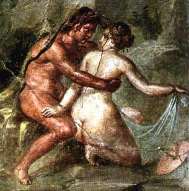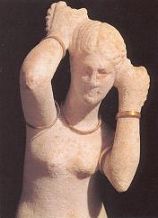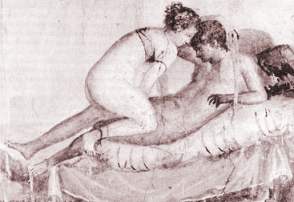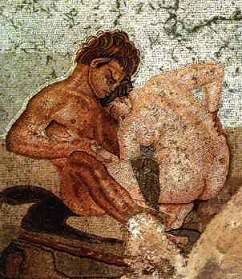Sexuality in the Roman Empire
A Society of Classes
At the outset, we must come to terms with the class nature of Roman society.
Not a simple understatement (for all societies have social strata of one sort
or another) but a vital part of determining the mores that would govern how
free Romans, particularly those of higher status, would act.
 For the wellborn, slaves were omnipresent.
A household would posses many whose purpose was to cater to every need of the
owner. The most mundane tasks we do for ourselves today– dressing, tying
the sash of a sandal, or even combing hair – were performed by slave attendants.
Recall the phrase in the gospel referencing one’s worthiness to "remove
his sandals." The owner was permitted to brush their own teeth, but even
here a personal option not exercised by all. Though the slave was always nearby
the master considered their presence as irrelevant. Think of this as similar
to how you might act today in the presence of your household dog or cat. In
other words, when we speak of the times Romans were alone it doesn’t actually
mean they were by themselves. Quite the contrary, often the slave was present
even in the most intimate of settings. The master’s bedroom contained the
slave’s cot, and unless the lovers requested its removal for an evening
it can be assumed it was occupied
For the wellborn, slaves were omnipresent.
A household would posses many whose purpose was to cater to every need of the
owner. The most mundane tasks we do for ourselves today– dressing, tying
the sash of a sandal, or even combing hair – were performed by slave attendants.
Recall the phrase in the gospel referencing one’s worthiness to "remove
his sandals." The owner was permitted to brush their own teeth, but even
here a personal option not exercised by all. Though the slave was always nearby
the master considered their presence as irrelevant. Think of this as similar
to how you might act today in the presence of your household dog or cat. In
other words, when we speak of the times Romans were alone it doesn’t actually
mean they were by themselves. Quite the contrary, often the slave was present
even in the most intimate of settings. The master’s bedroom contained the
slave’s cot, and unless the lovers requested its removal for an evening
it can be assumed it was occupied by the slave ready to respond
to the master’s request. (Do YOU put the dog out before lovemaking?) One
example recorded is of a man caught in his lover’s bedroom dissimulating
that he was not indeed there for the lady of the house, but for the slave who
obviously laid nearby. One humorist wrote, "When Andromache mounted Hector
their slaves stood at the door masturbating."
by the slave ready to respond
to the master’s request. (Do YOU put the dog out before lovemaking?) One
example recorded is of a man caught in his lover’s bedroom dissimulating
that he was not indeed there for the lady of the house, but for the slave who
obviously laid nearby. One humorist wrote, "When Andromache mounted Hector
their slaves stood at the door masturbating."
What drove Roman mores then is an issue of rank position and
power derived therein. It was never becoming for the Roman to do, act,
or be seen in any manner which would undermine their position of power.
Take the seemingly simple issue of nudity; today’s blanket assumption of
embarrassment, (or dare we still say shame?) from being seen naked is an unknown
principle in Rome. To be seen naked by a slave was as insignificant as being
seen in that state by a pet canary. But the inverse, to be seen naked by someone
of higher status was considered cause for anxiety. The master removes the slave’s
clothing for the explicit purpose of shaming them and reinforcing the power
they maintain over them. This helps place in context the crucifixion where Jesus
and all such executed subjects were stripped naked. Nudity among peers, such
as at the baths, was understood in a totally different light. In this case,
how one carried themselves while naked was a sign of status.
Sexual Relations
 Far
from being a society of libertines, the Romans observed several sexual taboos
which begin to focus our understanding of their true nature. Love making was
to occur only at night, with the exception of newlyweds who were accorded the
exception for the day after the wedding. The room was to be darkened by extinguishing
the lamp and the woman having left her brassiere on was never completely naked.
(As observed in adjacent fresco) Note the delicate balance in this
dance of sexual mores: The male appears naked as the dominate master, and at
the same time the woman is afforded the honor of being cloaked in darkness and
at the same time almost ritualistically clothed so as not to completely demean
her status to that of an actual slave….even though in the love drama
that is indeed the role she was expected to play.
Far
from being a society of libertines, the Romans observed several sexual taboos
which begin to focus our understanding of their true nature. Love making was
to occur only at night, with the exception of newlyweds who were accorded the
exception for the day after the wedding. The room was to be darkened by extinguishing
the lamp and the woman having left her brassiere on was never completely naked.
(As observed in adjacent fresco) Note the delicate balance in this
dance of sexual mores: The male appears naked as the dominate master, and at
the same time the woman is afforded the honor of being cloaked in darkness and
at the same time almost ritualistically clothed so as not to completely demean
her status to that of an actual slave….even though in the love drama
that is indeed the role she was expected to play.
 The
union between two individuals – heterosexual or homosexual – was
considered a pleasurable fact and posed no moral problem for the upper-class
Roman elite...although more complex than this statement implies. The moral condemnation
rested not in the general sense that an act was committed, but in the dangers
of undermining the power status of the individual in how the act was
engaged. Subservience was in all cases considered demeaning to the Roman. In
lovemaking, the man was never to be dominated. Where permissible for the woman
to give oral pleasure to the man, it was unacceptable for the man to reciprocate
without appearing servile and weak. If the woman straddled her lover, it was
to serve him and if necessary – much as a slave – do all the work.
Even more feared were amorous passions extending beyond the boudoir resulting
in the man becoming a slave to passions. (Ovid’s Book of Love
provided the cure for this ailment.)
The
union between two individuals – heterosexual or homosexual – was
considered a pleasurable fact and posed no moral problem for the upper-class
Roman elite...although more complex than this statement implies. The moral condemnation
rested not in the general sense that an act was committed, but in the dangers
of undermining the power status of the individual in how the act was
engaged. Subservience was in all cases considered demeaning to the Roman. In
lovemaking, the man was never to be dominated. Where permissible for the woman
to give oral pleasure to the man, it was unacceptable for the man to reciprocate
without appearing servile and weak. If the woman straddled her lover, it was
to serve him and if necessary – much as a slave – do all the work.
Even more feared were amorous passions extending beyond the boudoir resulting
in the man becoming a slave to passions. (Ovid’s Book of Love
provided the cure for this ailment.) 
In this light, the famed excess of Roman leaders is better understood
as an exaggerated display of macho-male domination used to further reinforce
their power. Whether it be the harem of Nero, or the slave boys of Tiberius,
the display purpose was the same – to dominate through passively being served
by the slave. Messalina, the wife of Claudius, provides an intriguing example
of the feminine manifestation. When becoming fixated on a male subject (given
she was Empress, obviously one of lower rank) she would force their compliance
to her sexual demands through threats of depriving them of their property, liberty,
or even their lives. In this case the male symbol of strength in intercourse,
was replaced by frequency. (Claudius eventually had her and all her "lovers"
killed. I suspect due more to power than jealously.)
the same – to dominate through passively being served
by the slave. Messalina, the wife of Claudius, provides an intriguing example
of the feminine manifestation. When becoming fixated on a male subject (given
she was Empress, obviously one of lower rank) she would force their compliance
to her sexual demands through threats of depriving them of their property, liberty,
or even their lives. In this case the male symbol of strength in intercourse,
was replaced by frequency. (Claudius eventually had her and all her "lovers"
killed. I suspect due more to power than jealously.)
In this context, homosexuality is seen quite differently. The
stigma was not attached to the homosexual act per se, but to the male that accepted
the passive position. Where there was no stigma for the female to be
the "slave" to the male in lovemaking (this being the natural order
as it were…) it was for the male who willingly subjected himself
to another male of greater power. To be sodomized was the height of passivity
and for a free man symbolized a lack of self-respect. This is not a democratic
distribution of sexual mores and stigma. Could it be, that in the ancient story
of Gilgamesh the people’s ridiculing and taunting of Enkidu was
not just a response to his fear of going to the Cedar Forest? Accepting the
relationship between these two as a given, might we have here the discriminatory
distribution of sexual stigma? Was Enkidu ridiculed for accepting the servile
sexual position regardless of having fought to a stalemate in a public display
of equal power?
 Pederasty
Pederasty
References in Rome (or earlier ancients for that fact) to sexual relations with
children was common. Again, understanding the context requires keeping the status
or rank of the figures involved always in mind. The wellborn Romans became accustomed
to keeping boy and girl slave children around the house as what can only be
described as child-pets. In the most fundamental sense they were cute, and having
them around at dinner, or evening to play with was accepted as privilege of
rank. Birds, dogs, rabbits - Romans preferred live toys in general.
The child-pet could be treated as a passive sexual object without danger of
degrading the adult master’s power or effecting the child’s status
which was passive by nature. At the first sign of maturity (masculinity in the
case of the boy) everything changed by virtue of the elevation of the child
to adult status. In other words treating the adult male in such a passive manner
as already discussed was viewed very differently. Any masters that kept their
child-pets after they stopped growing was considered reprehensible.
As Paul Veyne relates, "…it was proverbially held
that sex with boys procures a tranquil pleasure unruffling the soul." Examples
abound in almost overwhelming abundance. Ovid relates the story of Ganymede
as boy lover to Jove, as well as his description of Orpheus who turns to boys
as a tranquil consolation after having lost his wife.When revealed in public
these relationships were most often met with good natured humor or what appears
to be a playful taunting of the adult master. (The image shown
below is a Baroque painting by Rubens showing Jove’s Abduction of Ganymede.
The Baroque was never an age noted for its subtlety!)
In some cases the affection felt for the child was indeed more
than as a play object. Deep affection could grow between the adult and child
– which in no way assumes this to be a blood relation. In some ways closer
attachment could be lavished on the child-pet than on one’s own son because
of the son's eventual claim to inheriting family fortune and power. Just
how close do you want to become to someone who stands to gain from your death…natural
or otherwise?
This final return to the opening premise always focusing our
attention on the Roman obsession with rank and position reveals other interesting
possibilities. The child-pet if awarded their freedom by the master might then
become the owner of their father, who could (for a handsome price) be bought
as a slave. The conflicting paradox of power this would create would be pernicious,
and more than one family in history would collapse under its weight.
Humanities
Resource of Mark Hunter
 For the wellborn, slaves were omnipresent.
A household would posses many whose purpose was to cater to every need of the
owner. The most mundane tasks we do for ourselves today– dressing, tying
the sash of a sandal, or even combing hair – were performed by slave attendants.
Recall the phrase in the gospel referencing one’s worthiness to "remove
his sandals." The owner was permitted to brush their own teeth, but even
here a personal option not exercised by all. Though the slave was always nearby
the master considered their presence as irrelevant. Think of this as similar
to how you might act today in the presence of your household dog or cat. In
other words, when we speak of the times Romans were alone it doesn’t actually
mean they were by themselves. Quite the contrary, often the slave was present
even in the most intimate of settings. The master’s bedroom contained the
slave’s cot, and unless the lovers requested its removal for an evening
it can be assumed it was occupied
For the wellborn, slaves were omnipresent.
A household would posses many whose purpose was to cater to every need of the
owner. The most mundane tasks we do for ourselves today– dressing, tying
the sash of a sandal, or even combing hair – were performed by slave attendants.
Recall the phrase in the gospel referencing one’s worthiness to "remove
his sandals." The owner was permitted to brush their own teeth, but even
here a personal option not exercised by all. Though the slave was always nearby
the master considered their presence as irrelevant. Think of this as similar
to how you might act today in the presence of your household dog or cat. In
other words, when we speak of the times Romans were alone it doesn’t actually
mean they were by themselves. Quite the contrary, often the slave was present
even in the most intimate of settings. The master’s bedroom contained the
slave’s cot, and unless the lovers requested its removal for an evening
it can be assumed it was occupied by the slave ready to respond
to the master’s request. (Do YOU put the dog out before lovemaking?) One
example recorded is of a man caught in his lover’s bedroom dissimulating
that he was not indeed there for the lady of the house, but for the slave who
obviously laid nearby. One humorist wrote, "When Andromache mounted Hector
their slaves stood at the door masturbating."
by the slave ready to respond
to the master’s request. (Do YOU put the dog out before lovemaking?) One
example recorded is of a man caught in his lover’s bedroom dissimulating
that he was not indeed there for the lady of the house, but for the slave who
obviously laid nearby. One humorist wrote, "When Andromache mounted Hector
their slaves stood at the door masturbating." Far
from being a society of libertines, the Romans observed several sexual taboos
which begin to focus our understanding of their true nature. Love making was
to occur only at night, with the exception of newlyweds who were accorded the
exception for the day after the wedding. The room was to be darkened by extinguishing
the lamp and the woman having left her brassiere on was never completely naked.
(As observed in adjacent fresco) Note the delicate balance in this
dance of sexual mores: The male appears naked as the dominate master, and at
the same time the woman is afforded the honor of being cloaked in darkness and
at the same time almost ritualistically clothed so as not to completely demean
her status to that of an actual slave….even though in the love drama
that is indeed the role she was expected to play.
Far
from being a society of libertines, the Romans observed several sexual taboos
which begin to focus our understanding of their true nature. Love making was
to occur only at night, with the exception of newlyweds who were accorded the
exception for the day after the wedding. The room was to be darkened by extinguishing
the lamp and the woman having left her brassiere on was never completely naked.
(As observed in adjacent fresco) Note the delicate balance in this
dance of sexual mores: The male appears naked as the dominate master, and at
the same time the woman is afforded the honor of being cloaked in darkness and
at the same time almost ritualistically clothed so as not to completely demean
her status to that of an actual slave….even though in the love drama
that is indeed the role she was expected to play.
 the same – to dominate through passively being served
by the slave. Messalina, the wife of Claudius, provides an intriguing example
of the feminine manifestation. When becoming fixated on a male subject (given
she was Empress, obviously one of lower rank) she would force their compliance
to her sexual demands through threats of depriving them of their property, liberty,
or even their lives. In this case the male symbol of strength in intercourse,
was replaced by frequency. (Claudius eventually had her and all her "lovers"
killed. I suspect due more to power than jealously.)
the same – to dominate through passively being served
by the slave. Messalina, the wife of Claudius, provides an intriguing example
of the feminine manifestation. When becoming fixated on a male subject (given
she was Empress, obviously one of lower rank) she would force their compliance
to her sexual demands through threats of depriving them of their property, liberty,
or even their lives. In this case the male symbol of strength in intercourse,
was replaced by frequency. (Claudius eventually had her and all her "lovers"
killed. I suspect due more to power than jealously.)
